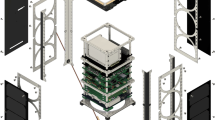Abstract
The primary scientific objectives of the Hard X-Ray Burst Spectrometer (HXRBS) to be flown on the Solar Maximum Mission are as follows: (1) To determine the nature of the mechanisms which accelerate electrons to 20–100 keV in the first stage of a solar flare and to > 1 MeV in the second stage of many flares; and (2) to characterize the spatial and temporal relation between electron acceleration, storage and energy loss throughout a solar flare.
Measurements of the spectrum of solar X-rays will be made in the energy range from 20 to 260 keV using an actively-shielded CsI(Na) scintillator with a thickness of 0.635 cm and a sensitive area of 71 cm2. Continuous measurements with a time resolution of 0.128 s will be made of the 15-channel energy-loss spectrum of events in this scintillator in anticoincidence with events in the CsI(Na) shield. Counting-rate data with a time resolution as short as 1 ms will also be available from a limited period each orbit using a 32K-word circulating memory triggered by a high event rate.
In the first year after launch, it is expected that approximately 1000 flares will be observed above the instrument sensitivity threshold, which corresponds to a 20–200 keV X-ray flux of 2 × 10−1 photons (cm2 s)−1 lasting for at least one second.
Similar content being viewed by others
References
Bai, T.: 1978, Solar Phys. 59, 141.
Datlowe, D. W., Elcan, M. J., and Hudson, H. S.: 1974, Solar Phys. 39, 155.
Dennis, B. R., Suri, A. N., and Frost, K. J.: 1973, Astrophys. J. 186, 97.
Dennis, B. R., Frost, K. J., Lencho, R. J., and Orwing, L. E.: 1977, Space Sci. Instr. 3, 325.
Dröge, F.: 1977, Astron. Astrophys. 57, 285.
Frost, K. J. and Dennis, B. R.: 1971, Astrophys. J. 165, 655.
Frost, K. J., Dennis, B. R., and Lencho, R. J.: 1971, in F. Labuhn and R. Lüst (eds.), ‘New Techniques in Astronomy’, IAU Symp. 41, 185.
Goodman, N. B.: 1976, Space Sci. Instr. 2, 425.
Hudson, H. S.: 1978, Astrophys. J. 224, 235.
Hurley, K. and Duprat, G.: 1977, Solar Phys. 52, 107.
Kaufman, P., Strauss, F. M., Opher, R., and Laporte, C.: 1979, Astron. Astrophys., in press.
Slottje, C.: 1978, Nature 275, 520.
van Beek, H. F.: 1973, ‘Development and Performance of a Solar Hard X-Ray Spectrometer’, Utrecht University (Ph.D. Thesis).
Author information
Authors and Affiliations
Rights and permissions
About this article
Cite this article
Orwig, L.E., Frost, K.J. & Dennis, B.R. The Hard X-Ray Burst Spectrometer on the Solar Maximum Mission. Sol Phys 65, 25–37 (1980). https://doi.org/10.1007/BF00151382
Received:
Revised:
Issue Date:
DOI: https://doi.org/10.1007/BF00151382




